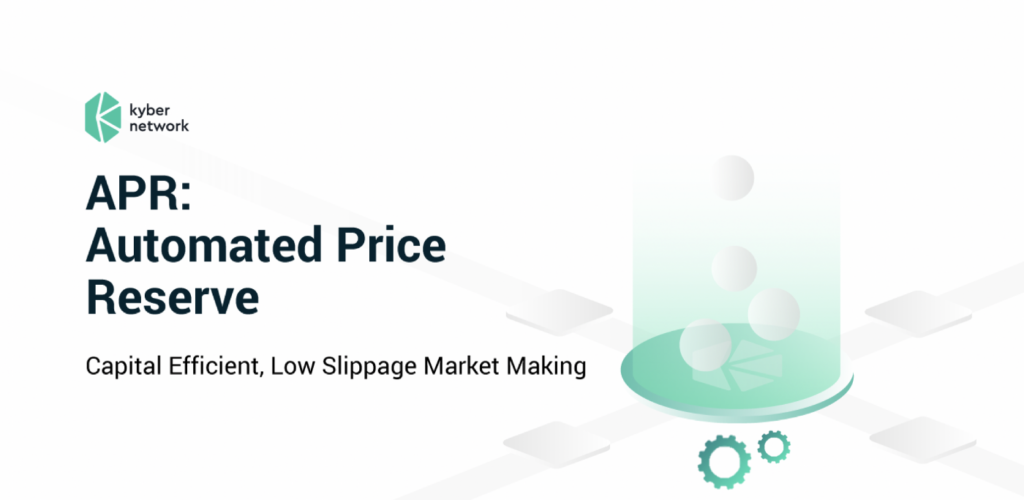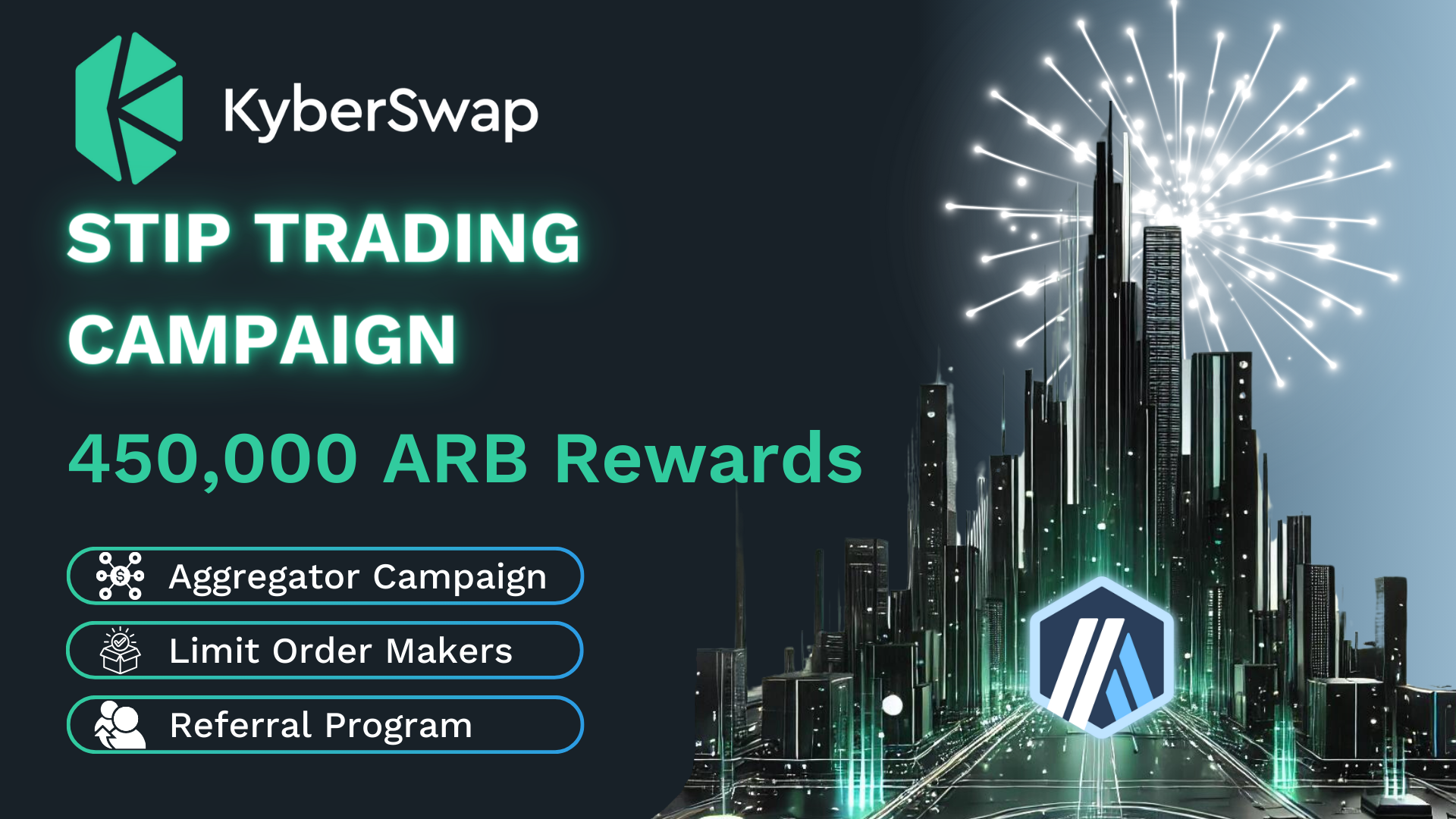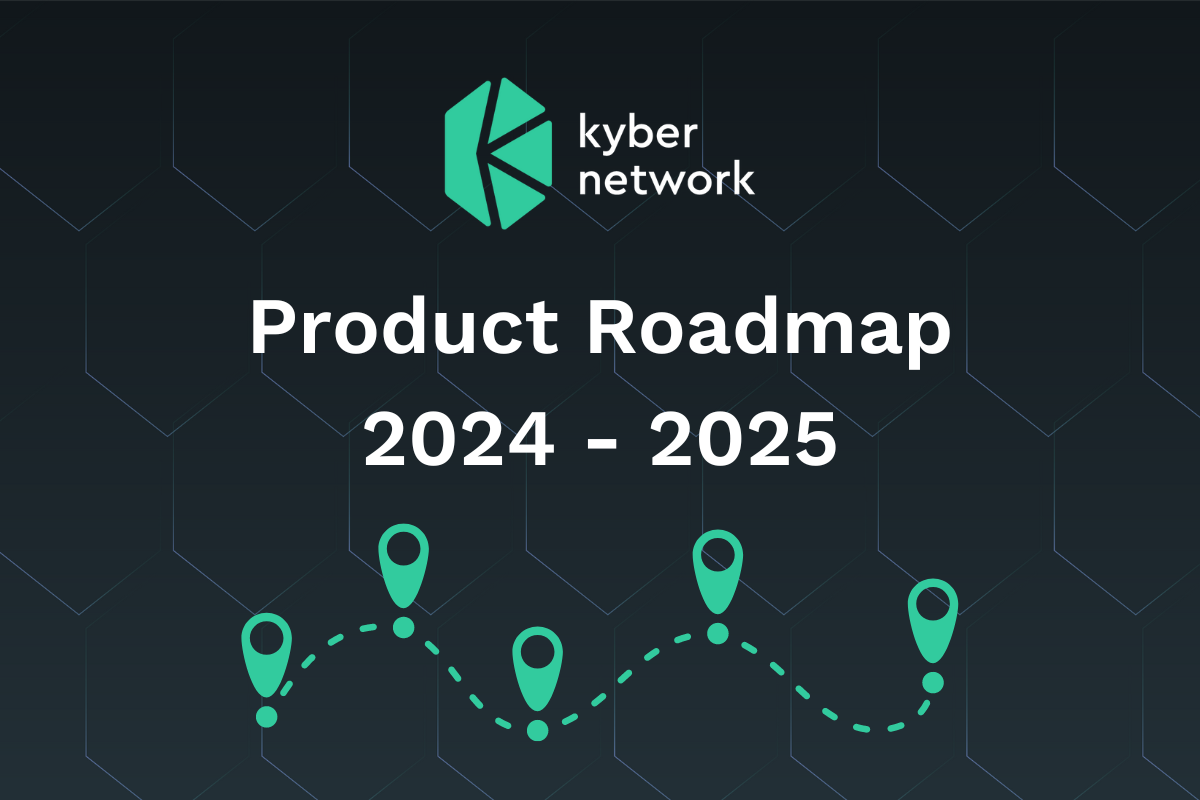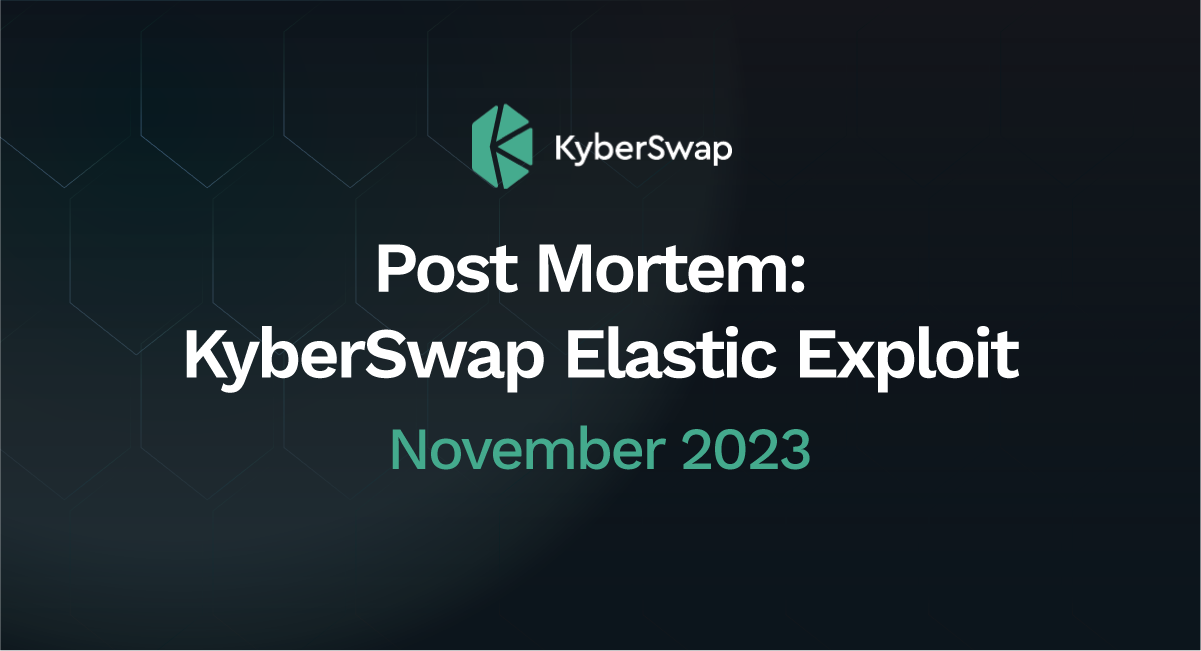Most efficient liquidity contribution method for token teams and individual token holders
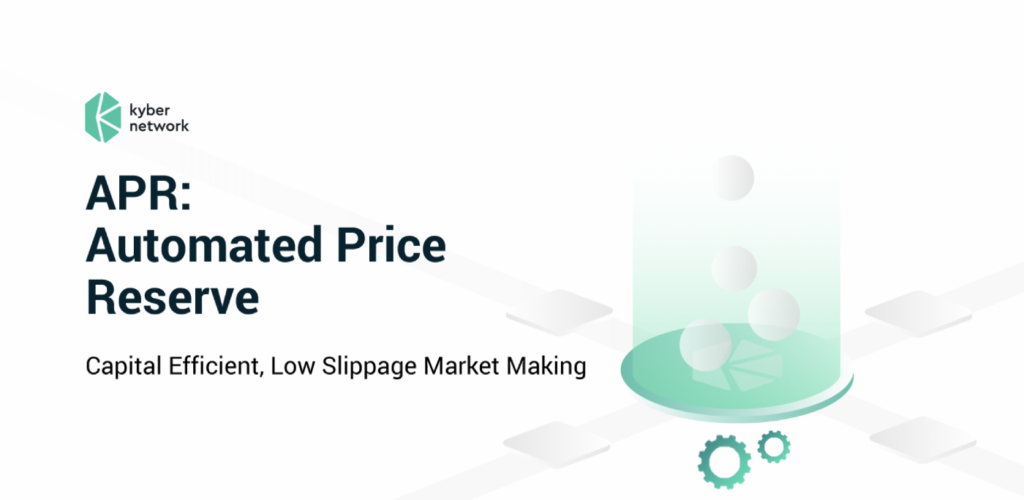
TLDR
- Kyber APR is highly suited for token teams that want to list their tokens and individuals who want to utilise their large token holdings.
- For the same price range and inventory, Kyber’s APR can provide a lot more liquidity, better slippage, and has the ability to serve more volume than other platforms.
- Many of the top token teams have already set up APRs, including Synthetix, Melon, DAOstack, and Gnosis.
- APR allows Reserve managers to: a) Provide liquidity for over 100 integrated platforms b) Market make for profit on each trade c) Save funds and resources by efficiently utilizing token inventory
Kyber ended 2019 on a very strong note, having facilitated over $500 million and 600,000 fully on-chain trades (we have since crossed $2 Billion and 1M+ trades). We are now the most used DeFi liquidity protocol in terms of users, with the highest number of integrations and the largest monthly volume on average.
Previously, we explained our bridge reserves and how they help Kyber to be a single liquidity endpoint for all on-chain use cases, particularly for DeFi applications. In this blog post, we will explain how token teams and whales can contribute liquidity to Kyber directly using the Kyber APR (Automated Price Reserve), an approach utilized effectively by teams such as Synthetix and Melon.
First off, let’s start with a simple overview of Kyber’s protocol and the reserve system. We will then explain the mechanics behind APRs and how they are different from other automated on-chain market makers. This will show why providing liquidity on Kyber is the most efficient use of token inventory for token teams and individuals, compared to other platforms.
Kyber Protocol Basics
Kyber is a fully on-chain protocol that is designed to be uniquely capable of supporting advanced pricing strategies and catering to the needs of decentralized financial DApps, yet exceedingly simple for integration into smart contracts.
In contrast to off-chain or hybrid/semi-off-chain models such as 0x, Kyber’s fully on-chain design allows for seamless composability with DApps, which require intricate smart contract interaction. In hybrid models, it is either not possible or very challenging to use within smart contracts, making it wholly unsuitable for more complex DeFi use cases. Since Kyber’s matching engine is purely on-chain, all transaction data is transparent, allowing anyone to verify that the taker has the best rate available. In the case of hybrid models that match off-chain, what you see may not be what you get.
To provide on-chain liquidity for takers, Kyber integrates a wide variety of liquidity providers, known as ‘Reserves’, into one single endpoint, using a ‘request for quotes’ system. Given a taker’s request, the protocol will ask a multitude of different reserves for the best quote and return it to them. This ensures that an on-chain taker will always achieve the best rates.
These 3 key reasons: fully on-chain liquidity, full transparency and verifiability, and liquidity aggregation, are the main reasons why the majority of popular DApps, particularly DeFi applications, are using Kyber as their single liquidity endpoint.
Kyber Reserves
Kyber currently has over 45 reserves. There are 3 main types of reserves: the first 2 types, Automated Price Reserve (APR)and Fed Price Reserve (FPR), are dedicated liquidity providers for Kyber, while the Bridge Reserve takes liquidity from other on-chain providers like Uniswap, Oasis, and Bancor.
For this blog post, we will be covering the Automated Price Reserve (APR).

APR (Automated Price Reserve) Benefits
The Kyber APR is highly suited for token teams that want to list their token and individuals who have large token holdings, and is designed with ease of maintenance as the top consideration. Many of the top token teams have already listed their tokens on Kyber by setting up APRs, including Synthetix, Melon, DAOstack, and Gnosis.
How the APR works
The APR relies on Kyber’s pre-defined algorithm set in the smart contract to automatically provide conversion rates for a token. It changes the price of the token based on the trades performed and the ETH/token inventory provided. The APR also provides Reserve managers the ability to set liquidity parameters that suit their specific needs and current market conditions. For more technical details, read this technical overview, and our APR documentation.
Why should token teams and individual holders contribute liquidity via Kyber APRs?
Kyber APRs provide many benefits for liquidity providers. Apart from providing listed tokens huge exposure to the DeFi ecosystem, APRs allow highly efficient utilisation of token inventory, ultimately ensuring better liquidity and spreadand lower slippage compared to other platforms, even for large orders. Below we highlight the 3 main APR benefits.
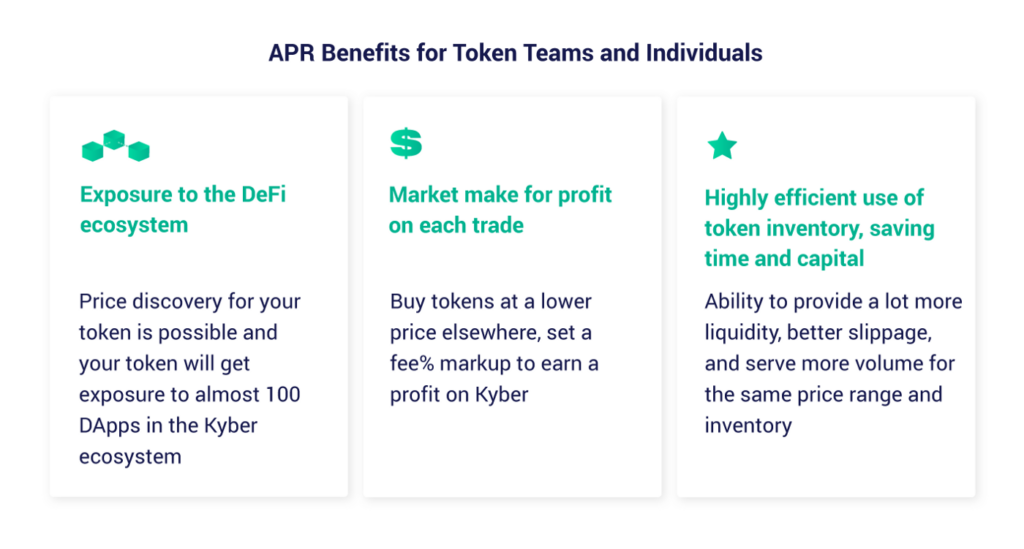
1. Provide Liquidity for the Entire Decentralized Ecosystem
Kyber is the most used DeFi protocol in the world, with the highest number of users and integrations, particularly for DeFi applications. By providing liquidity on Kyber, price discovery for your token is possible and your token will get exposure to over 100 DApps in the Kyber ecosystem. Moreover, Kyber’s protocol has been battle-tested, successfully facilitating over US$1 Billion and 1M+ trades entirely on-chain (Ethereum).
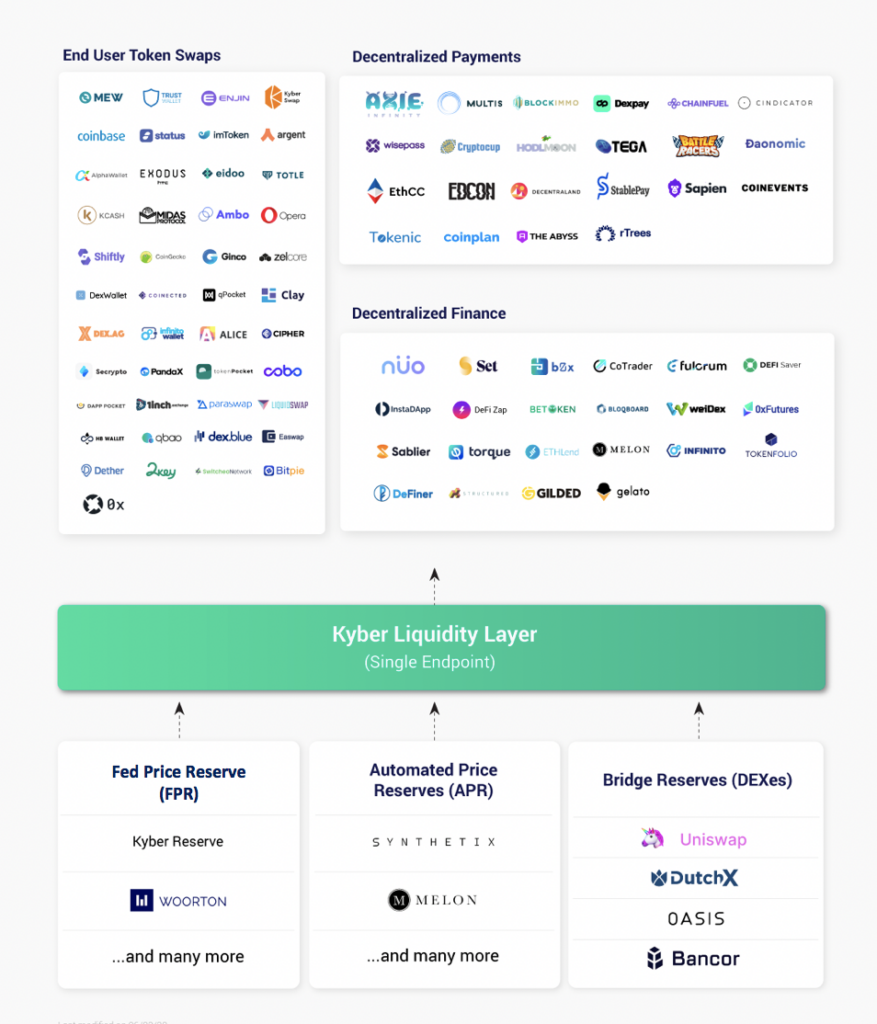
2. Market make for profit on each trade
Another key reason for providing liquidity on Kyber as an APR is the opportunity to market make for profit from each trade. As a reserve, you are able to buy tokens at a lower price elsewhere, then set a fee% markup to earn a profit on Kyber.
Example*
- Ren (REN) APR was set up at the end of January, 2019. By January, 2020, it had made ~181.8 ETH ($48,555 USD, ETH at $267) from fees.
*Estimated. Profits made are also dependent on the token demand, prices, liquidity, and popularity at the given scenario. Figures can be verified on-chain.
Katalyst Upgrades for Reserves
Once the Katalyst protocol upgrade is live, Reserves (including APRs) no longer need to maintain a KNC balance for fees, removing a major friction point, reducing costs, and simplifying reserve operations substantially. Kyber will also be able to split trades via reserve routing, combining quotes from different reserves for even better rates.
In addition, part of the total network fees collected will go towards incentivizing selected reserves based on how much trades and volume they facilitate for the network. This type of incentives for market makers, applicable to selected reserves, are known as rebates in traditional finance. Learn about the Katalyst upgrades here.
3. Highly efficient use of token inventory, saving resources
Kyber’s APR is the most ideal choice for token teams looking to contribute liquidity on-chain.
Token teams that provide liquidity to typical AMM (automated market maker)-style liquidity pools e.g. Uniswap or Bancor, might end up getting their token ‘priced to infinity’ by the AMM algorithm. In other words, for the standard AMM model, a portion of token inventory is being inefficiently allocated to price points that are not required by the market and are highly unlikely to hit in the short-medium term.
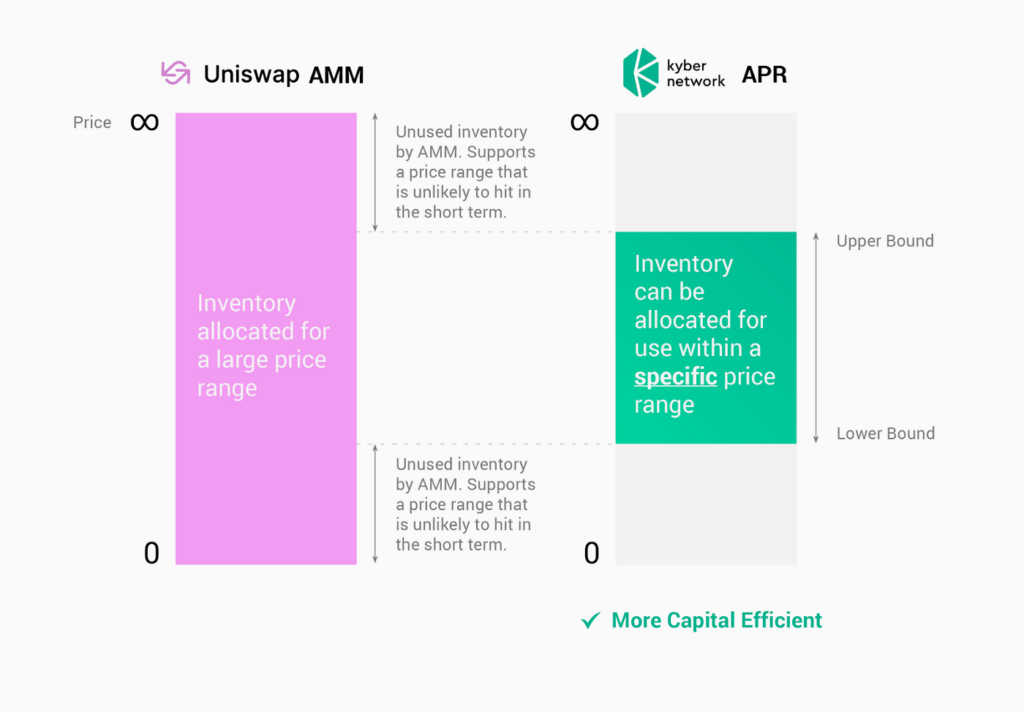
In comparison, for the same price range and inventory, Kyber’s APR can provide a lot more liquidity, better slippage, and serve more volume. As an example, a transaction of 1 ETH might move the price by 1% on a Kyber APR, while for the same amount on a different platform, the price might move by 2%. In such a scenario, Kyber would be able to serve 2 times more volume.
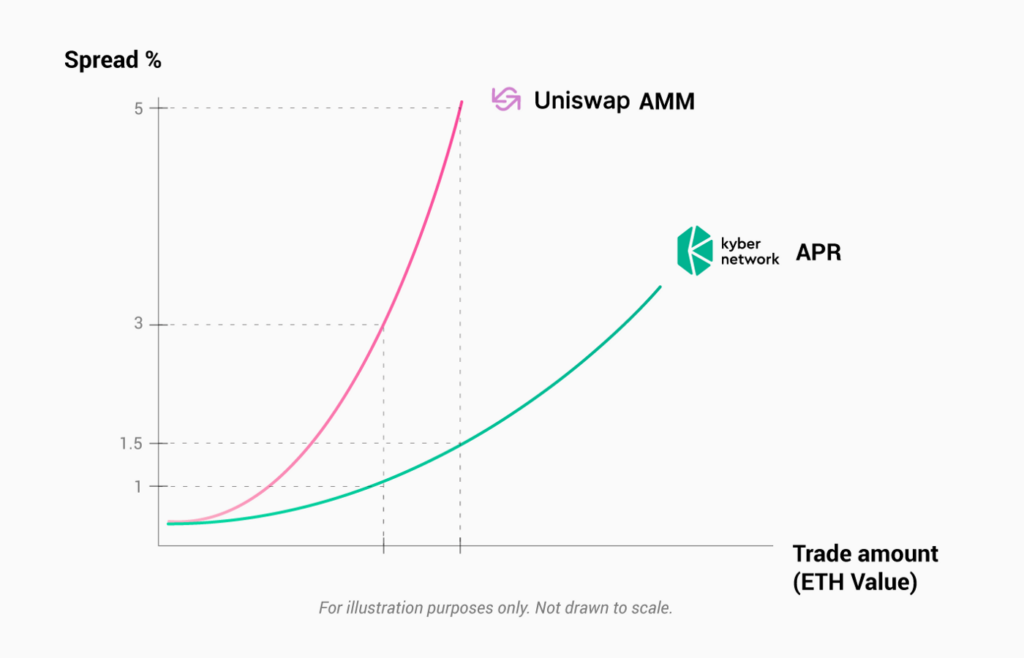
This is possible due to Kyber’s APR giving token teams the flexibility to price tokens within a specific, self-stipulated price range.
The tradeoff is that once the token price goes beyond the lower or upper bound set by the reserve manager, the APR reserve has to take time to rebalance its token inventory.
Comparison Of Capital Utilization (Examples)
Please note that these examples are for illustration purposes only.
1. To support a 50–200% Token Price Change
a) Slippage comparison assuming the same ETH Inventory size
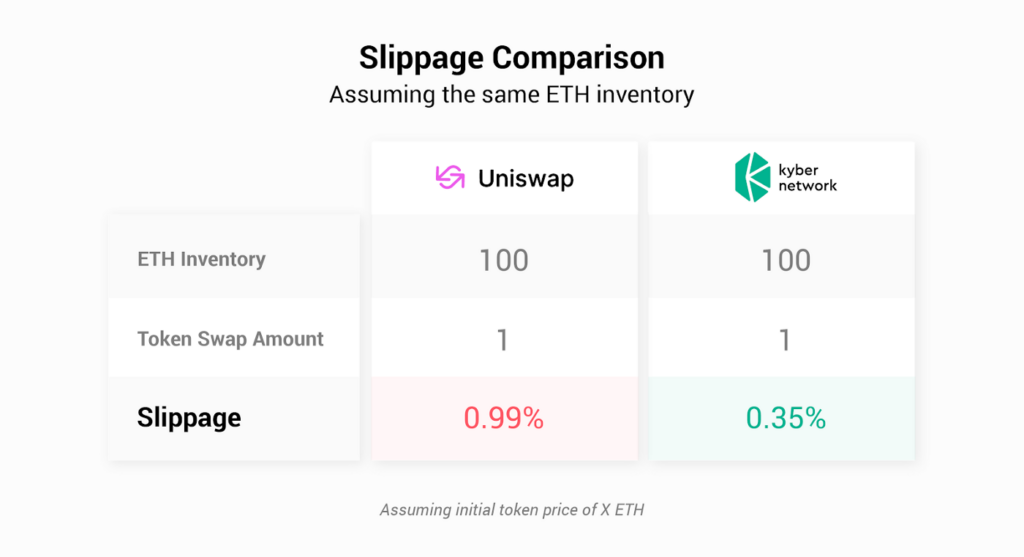
b) ETH Inventory required by respective platforms, assuming we want to achieve the same slippage level
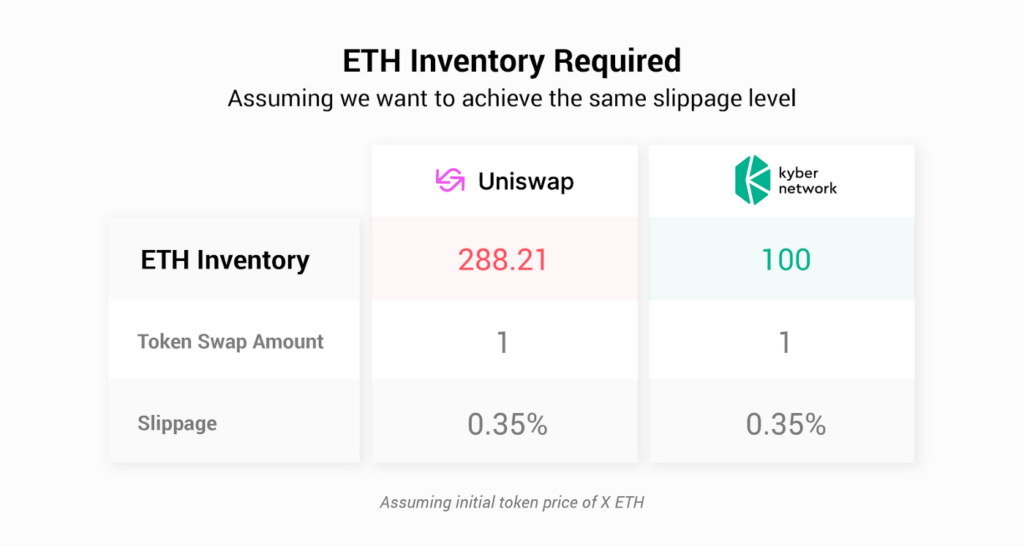
2. To support a 90–110% Token Price Change (e.g. low volatility stable coin pairs)
The advantages of the APR are especially prominent when it comes to stablecoin pairs such as those for DAI or USDC, which have less price fluctuations. For instance, the same token inventory used to support a 50% drop can now be used for a 10% drop, since the price won’t move as much. This means lower slippage and ETH inventory required on the APR.
a) Slippage comparison assuming the same ETH Inventory size
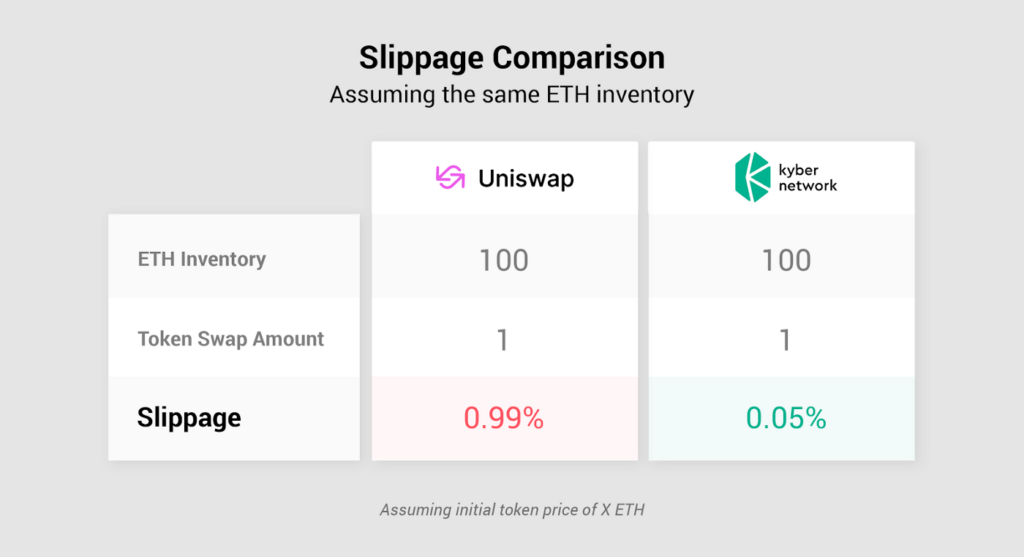
b) ETH Inventory required by the platform, assuming we want to achieve the same slippage level
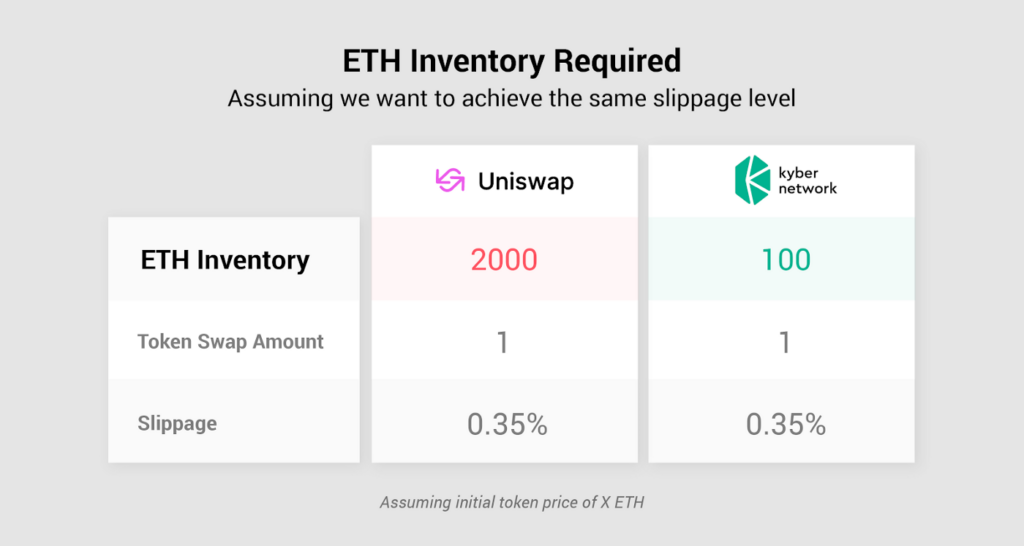
Getting Started on your APR
As evident from above, Kyber’s APR provides many advantages for liquidity providers. If you are a token team planning to list your token or an individual token holder who wants to utilise your spare token holdings, we highly recommend that you contribute liquidity on Kyber via an APR.
To begin, reach out to us on Discord and read this technical overview about the APR. You can find all the necessary documentation for setting up a reserve here: https://developer.kyber.network/docs/Reserves-Intro/ Your token has to be an ERC20 utility token.
Towards the Single Liquidity Endpoint for DeFi
Decentralized finance needs decentralized liquidity. Kyber already supports over 80 tokens, and we expect our Katalyst protocol upgrade and the incremental optimisation of our APR, FPR (and the KyberPRO framework), Bridge Reserve, and other reserve types to enhance our ability to connect and aggregate decentralized liquidity for DeFi use cases.
Together, these steps will further propel Kyber towards being able to provide takers and DApps with the single endpoint for their on-chain liquidity needs, ensuring they receive the best possible price (quote) for each trade, without needing to integrate multiple systems.
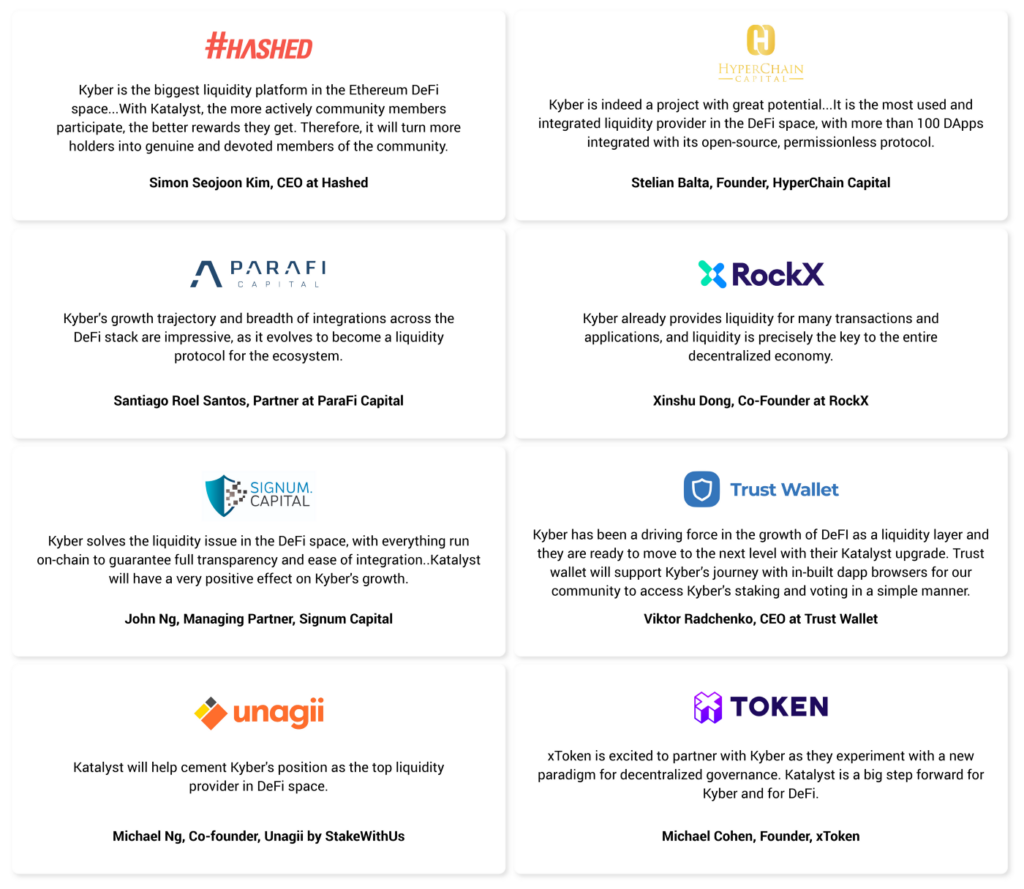
About Kyber Network
Kyber Network is delivering a sustainable liquidity infrastructure for DeFi. As a liquidity hub, Kyber connects liquidity from various protocols and sources to provide the best token rates to Dapps, aggregators, DeFi platforms, and traders.
Through Kyber, anyone can provide or access liquidity, and developers can build innovative applications, including token swap services, decentralized payments, and financial Dapps — helping to build a world where any token is usable anywhere. Kyber is powering more than 100 integrated projects and has facilitated over US$7 billion worth of transactions for thousands of users since its inception.
KyberSwap, the latest protocol in the liquidity hub, provides the best rates for traders and maximizes returns for liquidity providers.
Discord | Website | Twitter | Telegram | Forum | Blog | Reddit | Facebook | Github | KyberSwap | KyberSwap Docs
